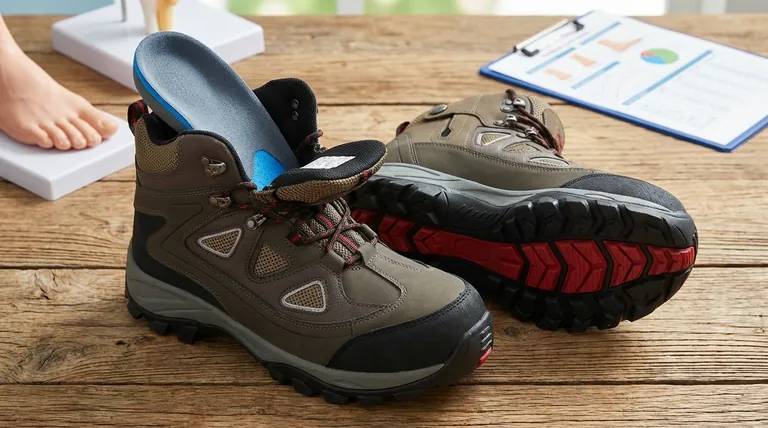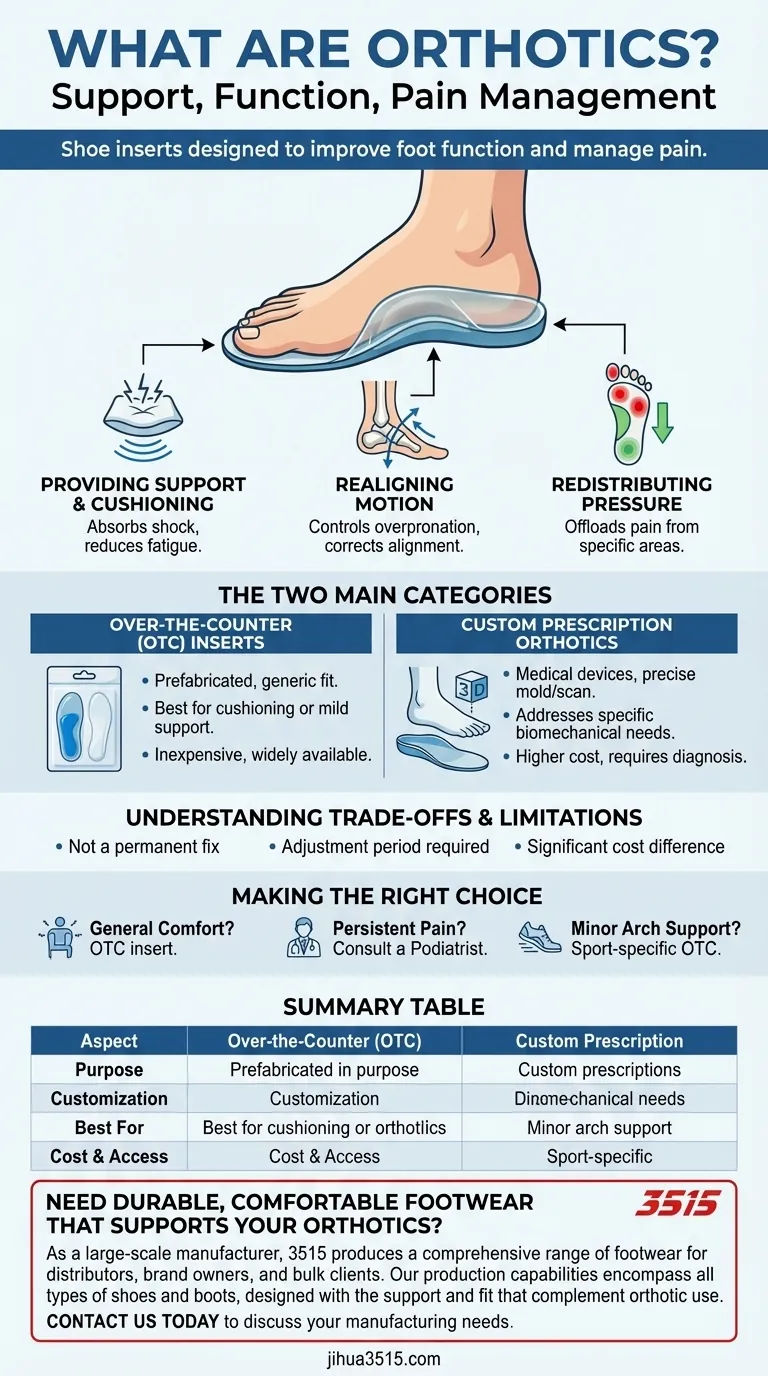At their core, orthotics are shoe inserts designed to support the foot, improve its function, and manage pain. They are not a one-size-fits-all solution, but a broad category of devices ranging from simple, cushioned insoles you can buy at a pharmacy to highly specific, medically prescribed inserts molded to your unique foot structure.
Orthotics are best understood as tools for support and pain management, not as permanent cures for structural foot problems. The critical distinction is between over-the-counter insoles for general comfort and custom orthotics designed to address specific biomechanical issues.

How Orthotics Actually Work
An orthotic changes the way your foot interacts with the ground as you walk or run. It achieves this through a few key mechanisms.
Providing Support and Cushioning
The most basic function of an orthotic is to provide arch support and add a layer of cushioning. This helps absorb the shock that travels up your leg with every step, reducing general foot fatigue and discomfort.
Realigning Foot and Ankle Motion
More advanced, rigid orthotics work by controlling motion. By supporting the arch and cupping the heel, they can help correct alignment issues, such as overpronation (when the foot rolls too far inward), which can contribute to pain in the feet, knees, and even the back.
Redistributing Pressure
For conditions like plantar fasciitis or metatarsalgia (pain in the ball of the foot), orthotics can be designed to offload pressure from the painful area. By redistributing your body weight more evenly across the foot, they give the inflamed tissue a chance to heal.
The Two Main Categories of Orthotics
It is essential to distinguish between the two primary types of orthotics, as they serve very different purposes.
Over-the-Counter (OTC) Inserts
These are prefabricated, mass-produced insoles made from materials like gel, foam, or plastic. They are designed to fit a general foot shape and are best suited for providing cushioning or mild arch support for minor foot pain.
Custom Prescription Orthotics
These are medical devices prescribed by a podiatrist or other healthcare professional. They are crafted from a precise mold or 3D scan of your feet and are built to address your specific biomechanical needs, foot shape, and medical condition.
Understanding the Trade-offs and Limitations
While effective, orthotics are not a magical solution. Understanding their limitations is key to having realistic expectations.
They Are Not a Permanent Fix
Orthotics manage symptoms and improve function, but they do not permanently correct underlying anatomical issues like flat feet. Their benefits are present only when you are wearing them.
There Is an Adjustment Period
Custom orthotics, particularly rigid ones, can feel strange or even uncomfortable at first. Your body needs time to adapt to a new way of walking, and a gradual break-in period is almost always required.
Cost and Accessibility
There is a significant difference in investment. OTC insoles are relatively inexpensive and widely available. Custom orthotics represent a much larger financial commitment and require a professional consultation.
Making the Right Choice for Your Goal
To select the right approach, you must first define your primary objective.
- If your primary focus is general comfort or relieving tired feet: A quality over-the-counter cushioned or gel insert is an excellent and cost-effective starting point.
- If your primary focus is addressing persistent or sharp pain: Consult a podiatrist to get an accurate diagnosis and determine if custom orthotics are necessary for your condition.
- If your primary focus is minor arch support for exercise: Look for a semi-rigid, sport-specific OTC insert designed to provide stability without being overly restrictive.
By understanding what orthotics can and cannot do, you can effectively use them as a tool to improve your comfort and maintain an active life.
Summary Table:
| Aspect | Over-the-Counter (OTC) | Custom Prescription |
|---|---|---|
| Purpose | General comfort, mild support | Address specific biomechanical issues |
| Customization | Prefabricated, generic fit | Molded/Scanned to your unique foot |
| Best For | Minor foot fatigue, cushioning | Persistent pain, alignment correction |
| Cost & Access | Inexpensive, widely available | Higher cost, requires professional diagnosis |
Need durable, comfortable footwear that supports your orthotics?
As a large-scale manufacturer, 3515 produces a comprehensive range of footwear for distributors, brand owners, and bulk clients. Our production capabilities encompass all types of shoes and boots, designed with the support and fit that complement orthotic use.
Contact us today to discuss your manufacturing needs and discover how we can deliver quality and value.
Visual Guide

Related Products
- Safety Footwear Wholesale Manufacturer for Custom OEM/ODM Production
- Wholesale Safety Footwear Manufacturer for Bulk & Custom OEM Orders
- Wholesale Customizable Safety Boots Durable & Protective Footwear Manufacturing
- Wholesale Lightweight Cushioned Athletic Sneakers for Custom Bulk Production
- Customizable Anti-Smash Safety Boots for Wholesale & Private Label Manufacturing
People Also Ask
- How long can you wear safety boots? The Lifespan is Determined by Wear, Not Time
- How do safety shoes contribute to cost savings for companies? A Strategic Investment in Risk and Cost Management
- Is safety-toe as good as steel toe? Choose the Right Protection for Your Job
- What are the differences between steel toe, composite toe, and alloy toe Wellington boots? Choose the Right Safety Toe for Your Job
- What are the cultural perspectives on wearing shoes in the house? A Guide to Home Etiquette & Hygiene



















